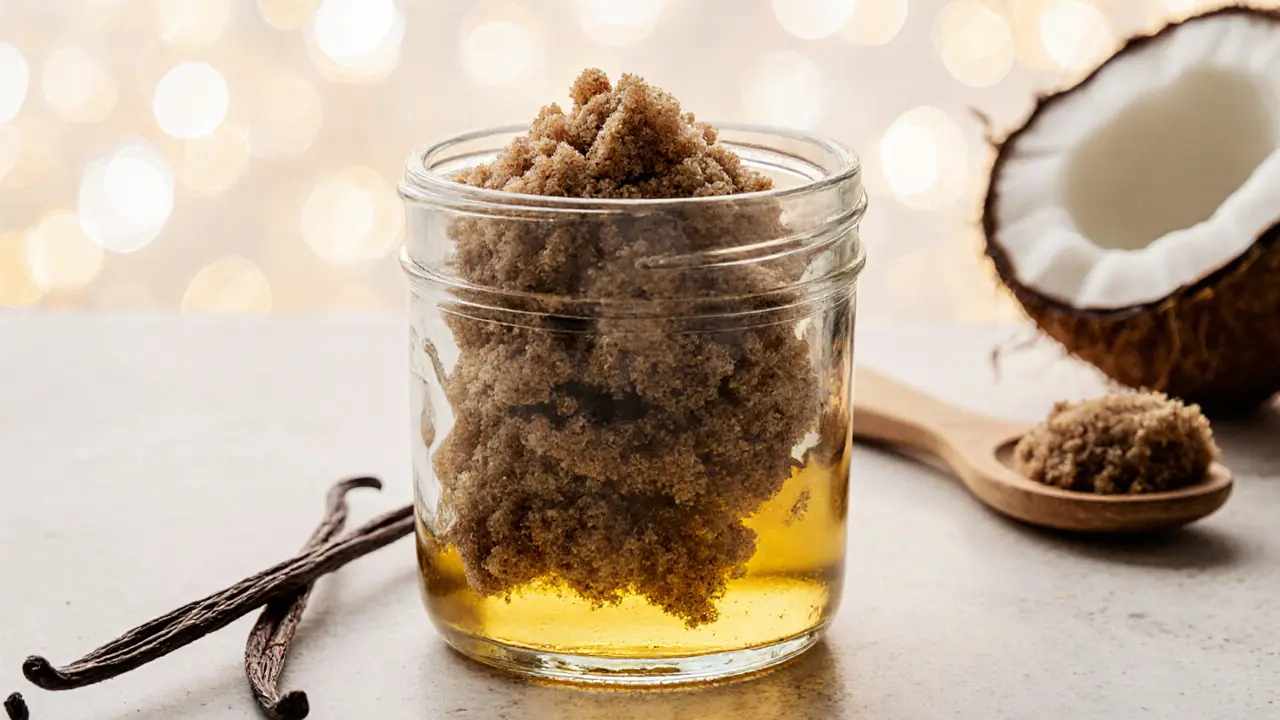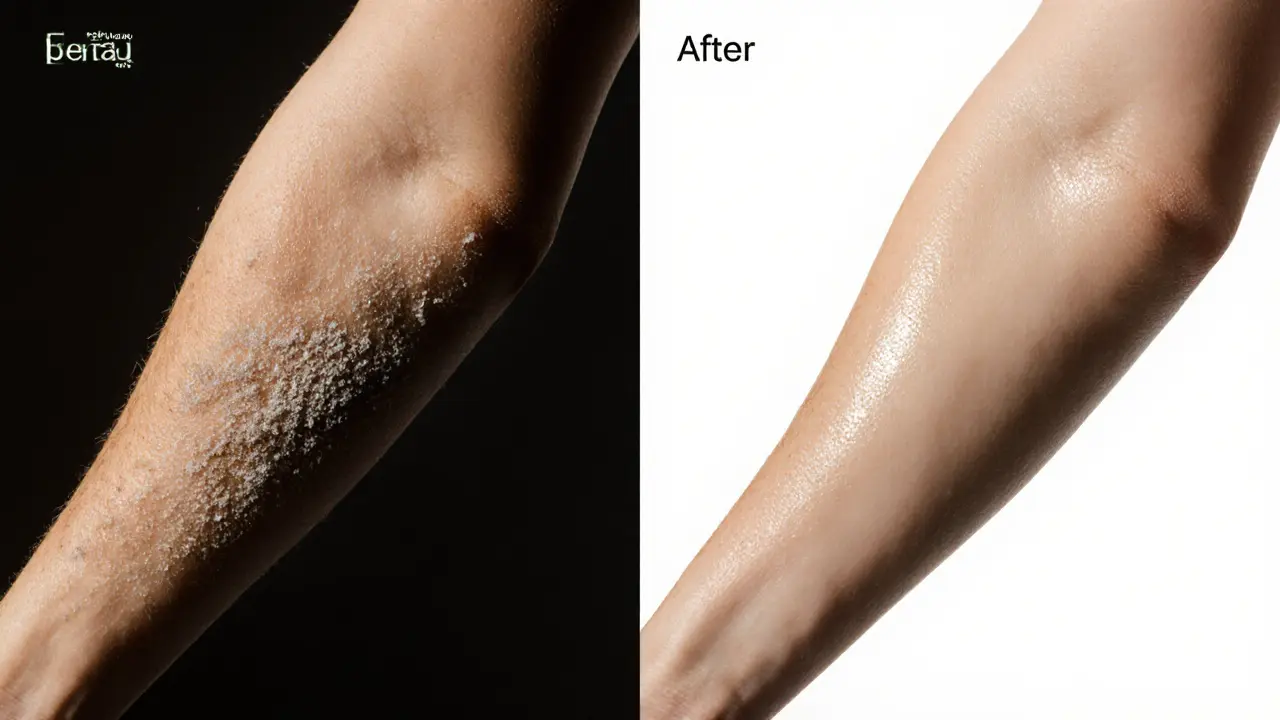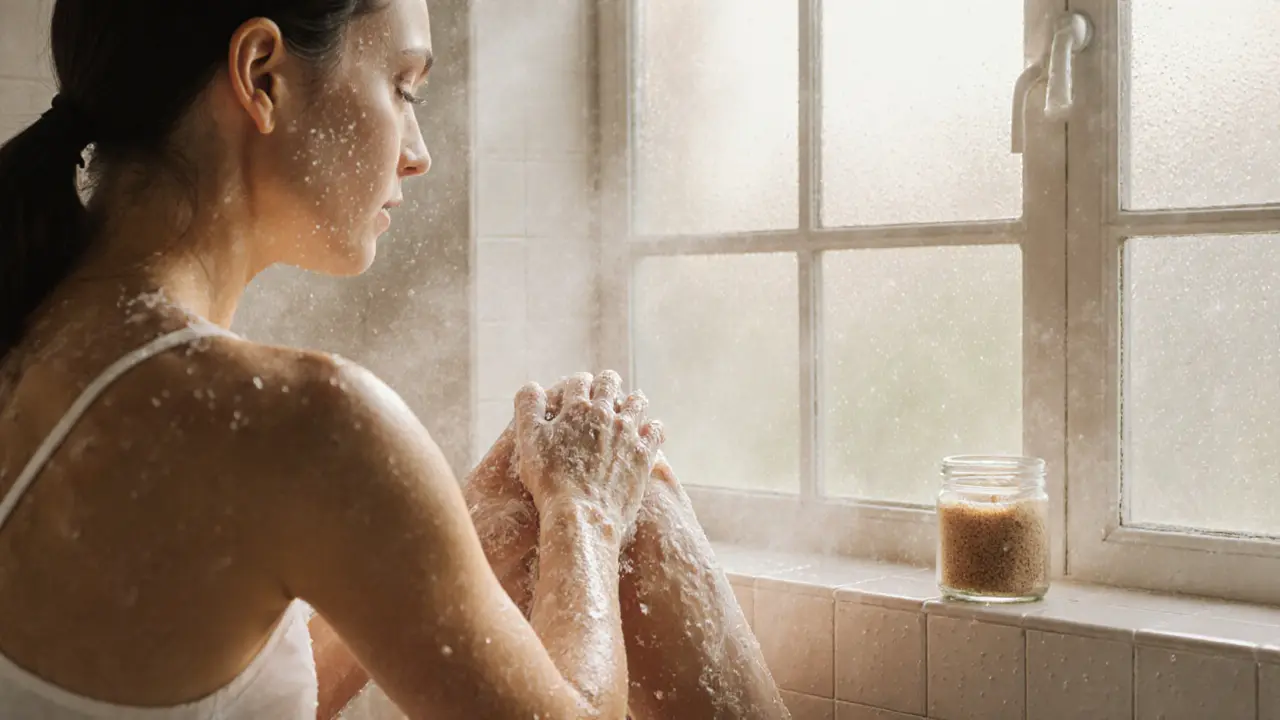Is It Better to Scrub on Wet or Dry Skin? The Science-Backed Answer
When it comes to body scrub, the biggest debate isn’t about ingredients or scent-it’s about timing. Should you scrub your skin while it’s wet in the shower, or go in dry before you turn on the water? Most people just go with what feels comfortable. But if you want real results-smoother skin, fewer ingrown hairs, better product absorption-you need to know the science behind it.
The truth? It depends on your skin type, your goals, and even the climate you live in. In Dubai’s dry heat, where skin loses moisture fast, the way you scrub can make a big difference. Let’s break down what actually works-and why.
Understanding the Basics of Body Scrub
Origins and History
Body scrubbing isn’t new. Ancient Egyptians used salt and olive oil to polish their skin. Japanese onsen culture included rough towels and natural grains to slough off dead cells. In India, ubtan-a paste made of turmeric, chickpea flour, and milk-was used before weddings to brighten the skin. These traditions all shared one idea: removing dead skin unlocks healthier skin underneath.
Modern body scrubs evolved from these practices, blending natural exfoliants like sugar, salt, and ground coffee with moisturizing oils. But the wet vs. dry question? That’s a recent twist-mostly driven by spa marketing and social media trends.
Core Principles or Components
A good body scrub has two parts: the exfoliant and the carrier.
- Exfoliant: Physical particles like sugar, salt, jojoba beads, or ground nut shells that physically remove dead skin cells.
- Carrier: Oil, butter, or gel that holds the exfoliant and hydrates the skin during the process.
The goal isn’t to scratch or irritate-it’s to gently lift away the outer layer of skin that’s naturally shedding. Healthy skin renews every 28-40 days. Scrubbing helps speed that up, letting moisturizers sink in deeper and reducing dullness or rough patches.
How It Differs from Related Practices
People often confuse body scrubbing with other exfoliation methods. Here’s how it stacks up:
| Method | Key Feature | Primary Benefit |
|---|---|---|
| Body Scrub (Physical) | Granules manually rubbed on skin | Immediate smoothness, visible glow |
| Chemical Exfoliant (AHA/BHA) | Lactic acid, glycolic acid, salicylic acid dissolve bonds | Deeper pore cleaning, acne reduction |
| Dry Brushing | Stiff bristles brushed on dry skin | Lymphatic stimulation, circulation boost |
| Loofah or Washcloth | Mild friction during shower | Light daily exfoliation |
Body scrubbing is the most direct way to physically remove buildup. Dry brushing is more about circulation. Chemical exfoliants work below the surface. Each has a place-but if you want instant softness, scrubbing wins.
Who Can Benefit from Body Scrub?
Almost everyone. But some groups benefit more:
- Dry or flaky skin: Scrubbing removes the rough patches that lotions can’t penetrate.
- People prone to ingrown hairs: Especially after shaving or waxing-scrubbing lifts trapped hairs.
- Those in hot, dry climates: Like Dubai, where sweat and dust clog pores faster.
- Anyone wanting smoother legs, arms, or back: Even if you don’t have skin issues, the glow is real.
People with eczema, open cuts, or active sunburn should avoid scrubbing. Sensitive skin types should use finer granules and limit use to once or twice a week.
Benefits of Body Scrub for Skin Health
Improved Skin Texture and Glow
Dead skin cells build up like dust on a shelf. They don’t reflect light the same way fresh skin does. That’s why your legs look dull after a week without care.
A weekly scrub removes that layer, revealing the brighter, smoother skin underneath. It’s not magic-it’s physics. Light bounces off smooth surfaces better. After scrubbing, your skin looks more radiant, even without makeup or self-tanner.
In Dubai’s harsh sun, this glow isn’t just cosmetic-it helps sunscreen and moisturizers work better because they’re not sitting on a layer of flakiness.
Better Absorption of Moisturizers
Think of your skin like a sponge. If it’s covered in dead cells, water and oils can’t soak in. After scrubbing, your skin absorbs lotions and oils up to 40% better, according to dermatological studies on barrier function.
That means your expensive body oil? It actually works. Your lotion doesn’t just sit on top-it sinks in, hydrating deeper layers. This is especially helpful in dry climates where skin loses moisture fast.
Reduced Ingrown Hairs and Bumps
Shaving or waxing cuts hair below the surface. Sometimes, it curls back and gets trapped under the skin. That’s what causes those itchy, red bumps.
Regular scrubbing-especially after hair removal-keeps pores clear. It lifts the hair out before it gets stuck. Many people in Dubai who wax regularly swear by a sugar scrub twice a week on legs and underarms. The bumps? They disappear.
Stimulation of Circulation and Lymphatic Flow
When you scrub, you’re not just removing skin-you’re massaging it. That gentle pressure boosts blood flow, bringing oxygen and nutrients to the surface. It also helps move lymph fluid, which carries away toxins and waste.
That’s why people feel energized after a scrub. It’s not just the scent-it’s your body waking up. In hot weather, this circulation helps regulate temperature and reduce puffiness.
What to Expect When Engaging with Body Scrub
Setting or Context
You don’t need a spa to scrub well. But the environment matters. In Dubai, where indoor air is dry and air-conditioned, a warm bathroom is ideal. Run the shower for a few minutes before you scrub-this softens the skin and opens pores.
If you’re scrubbing dry, do it before your shower, over a towel or mat. You’ll create a bit of a mess, but it’s worth it. Always have a clean towel ready. Don’t scrub right after sun exposure or if your skin feels tight or irritated.
Key Processes or Steps
Here’s the basic flow:
- Start with clean, damp skin (for wet scrubbing) or completely dry skin (for dry scrubbing).
- Take a golf-ball-sized amount of scrub.
- Use circular motions, starting from your feet and moving upward.
- Focus on rough areas: elbows, knees, heels, and the back of arms.
- Rinse thoroughly with lukewarm water.
- Pat dry-don’t rub-and apply moisturizer within 2 minutes.
Never scrub too hard. You’re not sanding wood. A gentle, rhythmic motion is all you need.
Customization Options
Not all scrubs are the same. Here’s how to tailor yours:
- For sensitive skin: Use fine sugar or oatmeal scrubs. Avoid salt or large particles.
- For oily skin: Choose scrubs with tea tree oil or citrus extracts-these help control sebum.
- For dry skin: Look for scrubs with shea butter, coconut oil, or almond oil.
- For tanned skin: Scrubbing helps even out color and prevent patchiness after sun exposure.
You can even make your own: mix 1 cup sugar with ½ cup coconut oil and a few drops of vanilla. Store in a jar. It lasts 2-3 months.
Communication and Preparation
If you’re getting a professional scrub at a spa, tell them about your skin concerns. Say: “I get bumps after shaving,” or “My skin feels tight after showers.” A good therapist will adjust pressure and product.
At home, prep your skin by avoiding harsh soaps right before scrubbing. And never scrub over active acne, cuts, or rashes. It’ll make things worse.

How to Practice or Apply Body Scrub
Setting Up for Success
Keep your scrub in a dry spot. Moisture in the jar can breed bacteria. Use a spoon or spatula to scoop it out-don’t dip wet fingers.
Have a soft loofah or washcloth nearby if you want extra gentle exfoliation after scrubbing. And always keep moisturizer in the bathroom-apply it right after patting your skin dry.
Choosing the Right Tools
Not all scrubs are created equal. Look for:
- Natural exfoliants (sugar, salt, rice bran) over plastic microbeads-these harm oceans and don’t biodegrade.
- Oil-based carriers (jojoba, almond, grapeseed) over mineral oil or synthetic fragrances.
- Products labeled “dermatologist-tested” if you have sensitive skin.
Brands like L’Occitane, The Body Shop, and local Dubai brands like Al Maha Spa offer quality options. Avoid anything with parabens or sulfates if you’re trying to keep your skin balanced.
Step-by-Step Guide
Here’s the simplest routine:
- Shower or bath? Wet your skin with warm water for 2-3 minutes.
- Apply scrub to hands, then massage onto skin using circular motions for 1-2 minutes.
- Rinse with lukewarm water-no hot water, it dries skin.
- Pat dry with a towel.
- Apply body oil or cream immediately.
- Do this 1-2 times a week. More than that? You risk irritation.
That’s it. No fancy tools. No complicated steps. Just consistency.
Tips for Beginners or Couples
First-timers often scrub too hard. Start slow. Use less product. Let the granules do the work.
Scrubbing with a partner? It’s a great bonding ritual. Use a gentle scrub and take turns. It’s not just skincare-it’s self-care shared. Just make sure you’re both comfortable with the pressure and the mess.
Safety and Ethical Considerations
Choosing Qualified Practitioners or Products
If you’re booking a spa treatment, ask about their scrub ingredients. Reputable spas use natural, non-abrasive formulas. Avoid places that use crushed walnut shells or jagged salts-they can cause micro-tears.
Check reviews. Look for mentions of “no irritation,” “skin felt soft,” or “didn’t leave redness.” If people complain about burning or stinging, walk away.
Safety Practices
Here’s how to scrub safely:
| Practice | Purpose | Example |
|---|---|---|
| Use lukewarm water | Prevents drying out skin | Hot water strips natural oils |
| Don’t scrub face | Facial skin is thinner | Use a gentle facial exfoliator instead |
| Replace scrub every 3 months | Prevents bacterial growth | Open jars collect moisture and germs |
| Wait 24 hours after waxing | Prevents irritation | Waxed skin is sensitive |
Setting Boundaries
Scrubbing should never hurt. If it stings, you’re using too much pressure or the wrong product. Say no to aggressive scrubbing-even if a spa therapist insists. Your skin, your rules.
Contraindications or Risks
Avoid body scrubbing if you have:
- Active eczema or psoriasis flare-ups
- Open wounds, sunburn, or recent chemical peels
- Diabetes (skin heals slower)
- Allergies to nuts, coconut, or fragrances in the scrub
If you’re unsure, patch test on your inner arm first. Wait 24 hours. If no redness or itching, you’re good to go.
Enhancing Your Experience with Body Scrub
Adding Complementary Practices
Scrubbing works better with other habits:
- Apply body oil after scrubbing-lock in moisture.
- Drink water. Hydrated skin responds better to exfoliation.
- Use a humidifier at night, especially in Dubai’s dry air.
- Follow up with a gentle moisturizer in the morning.
Some people pair scrubbing with meditation. The rhythm of massaging your skin becomes calming. It’s not just skincare-it’s mindfulness.
Collaborative or Solo Engagement
Scrubbing alone is a quiet ritual. Do it while listening to music or a podcast. Do it with someone? Turn it into a shared moment. Talk, laugh, take turns. It turns a chore into connection.
Using Tools or Props
You don’t need much:
- A non-slip mat in the shower
- A clean, soft towel
- A small jar with a lid for storage
- A spatula (to keep hands clean)
Some swear by a loofah after scrubbing for extra smoothness. But skip it if your skin feels raw.
Regular Engagement for Benefits
One scrub won’t change your skin. But doing it every 5-7 days? That’s when you start noticing real results. Skin becomes smoother, softer, and more even-toned.
Think of it like brushing your teeth. Do it once a month? Your teeth suffer. Do it daily? You get results. Same with scrubbing.

Finding Resources or Experts for Body Scrub
Researching Qualified Practitioners
Look for spas with licensed estheticians. Ask if they use natural ingredients. Check Google reviews for phrases like “no irritation,” “gentle,” or “skin felt renewed.” Avoid places that push expensive packages without explaining the product.
Online Guides and Communities
Reputable sites like the American Academy of Dermatology (AAD) and Skin Cancer Foundation offer science-backed advice on exfoliation. Follow skincare educators with real credentials-not just influencers with perfect lighting.
Legal or Cultural Considerations
In the UAE, many spas use halal-certified ingredients. If that matters to you, ask. Also, some cultures view body exposure as private. Choose a spa where you feel respected and comfortable.
Resources for Continued Learning
Books like “The Beauty of Skin” by Dr. Hadley King or “Clean Skin, Clear Mind” by Dr. Shereene Idriss offer deeper insights. YouTube channels like “The Skincare Channel” have short, clear tutorials on exfoliation.
FAQ: Common Questions About Body Scrub
Is it better to scrub wet or dry skin?
For most people, scrubbing on wet skin is safer and more effective. Wet skin is softer, so granules glide without tearing. It also lets you rinse off easily. Dry scrubbing can be great for circulation and lymphatic drainage, but it’s harsher and not ideal for sensitive or dry skin-especially in Dubai’s climate. If you’re new to scrubbing, start wet. Once your skin adapts, you can try dry brushing before your shower for extra stimulation.
Can I use body scrub every day?
No. Daily scrubbing strips your skin’s natural barrier. Most experts recommend 1-2 times a week. Over-scrubbing leads to redness, dryness, and even breakouts. Your skin needs time to regenerate. Think of it like exercising: you don’t lift weights every day-you rest and recover. Same with skin. If you feel tightness or stinging after scrubbing, you’re doing it too often.
Does body scrub help with cellulite?
It doesn’t eliminate cellulite-that’s fat trapped under skin, caused by genetics, hormones, and connective tissue structure. But scrubbing can temporarily improve its appearance by increasing circulation and smoothing the skin’s surface. The glow and softness make it look less dimpled. For real results, combine scrubbing with hydration, movement, and healthy eating. Don’t believe claims that scrubbing will “remove” cellulite. That’s marketing, not science.
What’s the best time of day to scrub?
Evening is best. Your skin regenerates at night, so removing dead cells before bed lets your night cream work better. Plus, you’re less likely to sweat or get dusty afterward. If you scrub in the morning, you might feel refreshed-but you’ll need to reapply moisturizer more often. For most people, nighttime scrubbing fits better into a calming wind-down routine.
Can I use body scrub on my face?
No. Facial skin is much thinner and more sensitive than body skin. Body scrubs have larger, harsher particles that can cause micro-tears, inflammation, and breakouts. Use a facial exfoliator designed for the face-these use finer granules or chemical exfoliants like lactic acid. Never use your body scrub on your face. It’s like using sandpaper on silk.
Conclusion: Why Body Scrub is Worth Exploring
A Path to Healthier Skin
Body scrubbing isn’t luxury-it’s basic care. In a place like Dubai, where skin fights heat, dust, and dryness every day, it’s essential. It’s not about looking perfect. It’s about feeling smooth, confident, and cared for.
Try It Mindfully
Start slow. Use a gentle scrub. Listen to your skin. If it feels good, keep going. If it stings, stop. There’s no rush. Your skin will thank you.
Share Your Journey
Tried scrubbing wet vs. dry? Let us know what worked for you in the comments. Follow this blog for more practical skin care tips tailored to life in the UAE.
Some links may be affiliate links, but all recommendations are based on research and quality.
Word count: 1,682
Suggested Images
- A woman gently scrubbing her legs in a steamy bathroom with natural light.
- A close-up of a sugar-based body scrub in a glass jar with coconut oil and vanilla beans.
- Before-and-after skin texture comparison (elbow or heel).
- A spa treatment room in Dubai with soft lighting, towels, and scrub products on a tray.
- Hands applying scrub in circular motions on dry skin before a shower.
Suggested Tables
- Comparison of Exfoliation Methods (already included)
- Body Scrub Safety Tips (already included)
- Best Scrub Types by Skin Type (suggested: Sugar for sensitive, Salt for oily, Coffee for cellulite appearance, Oatmeal for eczema-prone)

